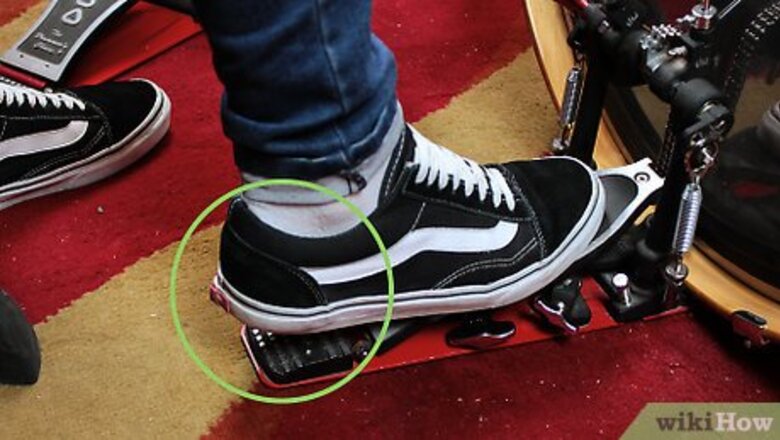
views
Using the Heel-up Method
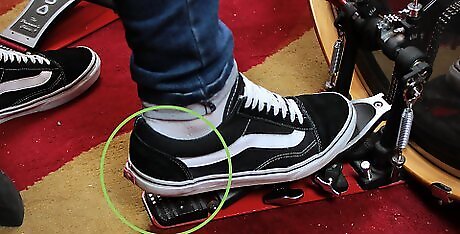
Place your feet on the pedals with your heels lifted. Your heels should be just hovering over the base of the pedal (or the floor depending on the size of your pedals and the size of your feet). You might want to adjust your stool to be a bit higher so your thighs are angled slightly downward. Avoid raising your stool too high because it might cause you to slouch or have trouble reaching the pedals. Adjust it to a height where your lower legs and thighs make a 90 to 110 degree angle.
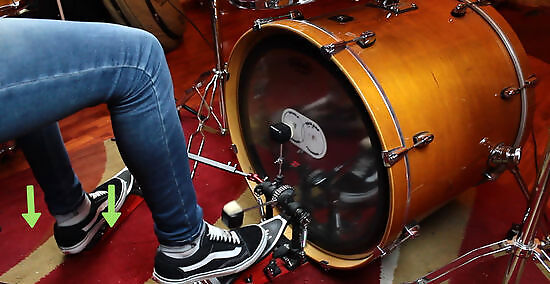
Push the pedal down with the ball of your foot. Apply a quick jolt of pressure to the pedals using the part of your foot between your toes and arches. Playing with the balls of your feet will give you more control and consistency. Avoid playing with your toes as this will make your playing less uniform and you might feel extra strain on those small muscles in your toes.
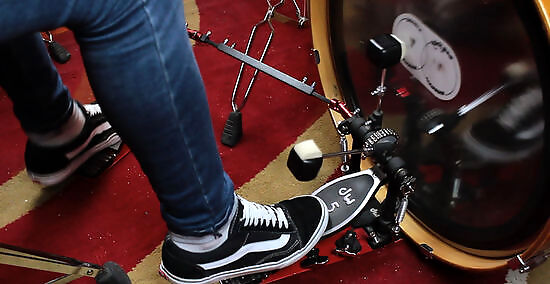
Alternate pushing down the left and right balls of your feet. Play very slowly to get used to the feeling of switching off feet. You should feel the most activity going on with your hamstrings, which might become a little sore after practicing for a while—don’t worry, that will subside the more you play! If placing your feet at the top of the pedal is uncomfortable for you, slide your foot down toward the base of the pedal so your toe is at the midpoint. Use ankle weights for 20 minutes of your practice to help increase your speed and endurance. Once you take them off, your feet will feel like they’re floating above the pedals. Practice playing heels up with easier songs like Queen’s “We Will Rock You” and The White Stripes’ “Seven Nation Army.”
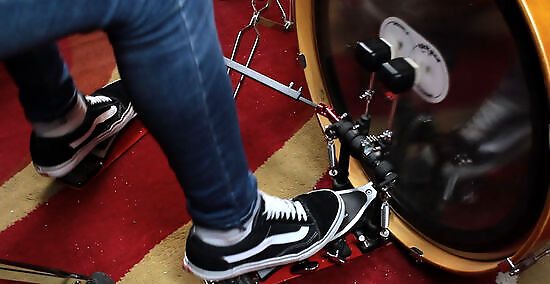
Practice with quarter, eighth, and sixteenth notes. Playing heels-up allows you to play very quickly, so after practicing very slowly with quarter notes, gradually increase your speed until you’re able to play fills and triplets using eighth and sixteenth notes. Add in some snare with your hands once you’ve mastered each speed. “Up All Night” by Blink 182 features sixteenth note triplet fills that you can practice very slowly at first to get the hang of it. Sixteenth notes are basically eighth notes split into two smaller chunks (i.e., four sixteenth notes are equal to two eighth notes which are equal one quarter note in a 4/4 time signature). A drum fill is when you play something that isn’t part of the main drum beat of that specific part of the song. For instance, the very first drumming you hear in Nirvana’s “Smells Like Teen Spirit” is fill (up until the regular beat). Triplets are when 3 notes are played in a different duration than the regular beat. Triplet notes are ⅔ the time of regular notes (e.g., a standard quarter note triple is ⅔ the duration of a regular quarter note and 3 eighth note triplets are equal to one quarter note) which means you’ll need to play more notes in order to meet the note value.
Playing Heel Down
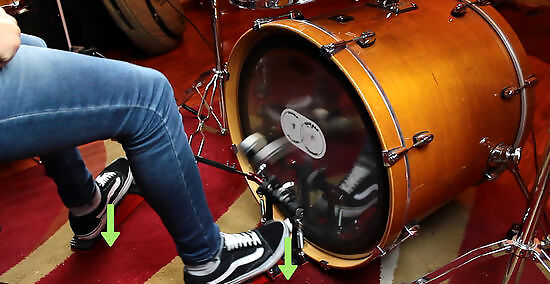
Rest your feet on the pedals and put the weight from your legs on your heels. Push the pedals by changing your ankle position. This playing position allows the drum beater to rebound off the drum, creating more resonant, tonal sounds. If you’re a jazz drummer, you’ll definitely want to experiment with playing heels-down. Dave Brubeck’s “Take Five” is an easy classic that will help you practice the heel-down technique.
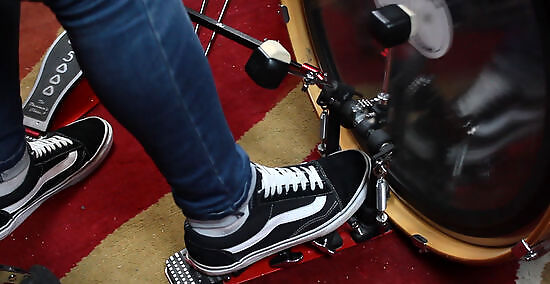
Lift up the front part of your right foot. While the toes and ball of your right foot are lifted, push the front part of your left foot down on the opposite pedal. Overexaggerate your movements at first to get it down and figure out which foot is weaker (so you can focus on getting that foot equal with the other). You may notice that your shins and ankles get sore after practicing for a while, but don’t worry, this will go away the more you practice. Stretching your shins, calves, and soles of your feet will help with any soreness. Doing calf raises will help strengthen the muscles in your lower legs and feet.
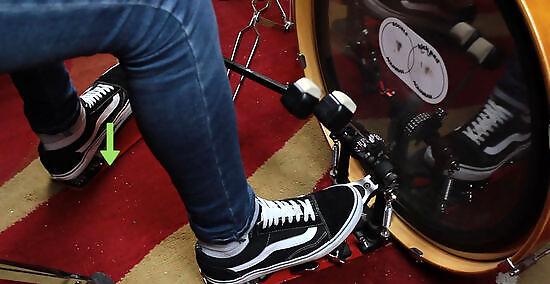
Lower the front part of your right foot. This will cause the drum beater to strike the right bass drum. Lift the front part of your foot after the beater strikes so it can bounce back. Remember to keep your toes relaxed and play with the entire front part of your foot, not just the ball or toes. To control the pedal rebound, only lift the front part of your foot from the pedal half way once the beater has struck the drum. This will also allow you to play another beat right away as a down-beat.
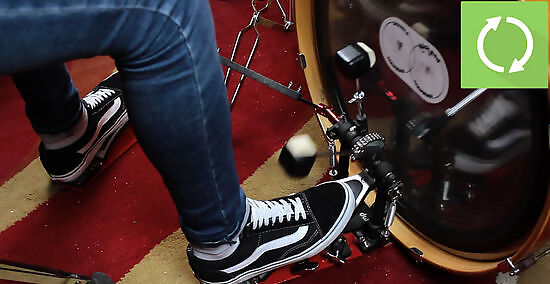
Practice alternating between both feet. Practice playing with both feet with quarter or eighth notes. Quarter notes mean there are 4 notes per measure (you’ll be putting each foot down twice to strike the drums within a single measure). Eighth notes mean you’ll be playing 4 short beats on your left foot and 4 on your right in alternating order. Play along to a metronome to get your foot timing and coordination down. Set your metronome to 60 beats per minute and start by playing one foot and then the other at each tick. Then speed it up by playing one foot on the tick and the other between ticks. Once you’ve gotten the hang of it, add in some snare and symbols with your hands. You can host a jam session to play along with friends. “Cantaloupe Island” by Herbie Hancock has a nice, easy tempo for practicing this technique. Slow it down and only play the foot parts before adding your hands into the mix.
Rolling Your Feet
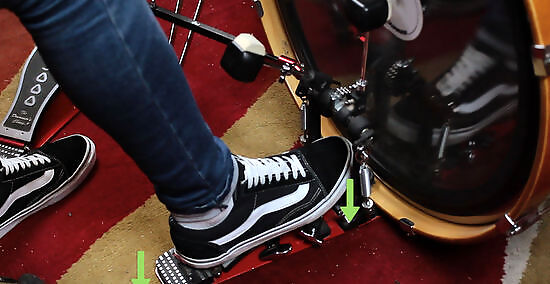
Hover your dominant foot over the pedal and push down with the ball. Your heel will be slightly lifted during this motion, but not as high off of the pedal as it would be while playing the heels-up method. Ignore the other foot for the moment for the purposes of getting the rolling motion down with just one.
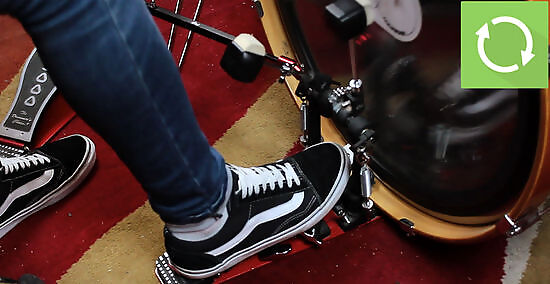
Push downward with your heel when you feel the beater spring back. You’ll basically be moving your heel downward as the front part of your foot comes back up and vice versa. You should feel both your shins, hamstrings, and ankles engaged while performing this rolling move with your foot. Record a video of your foot while you’re playing with this technique so you can spot any technical errors.
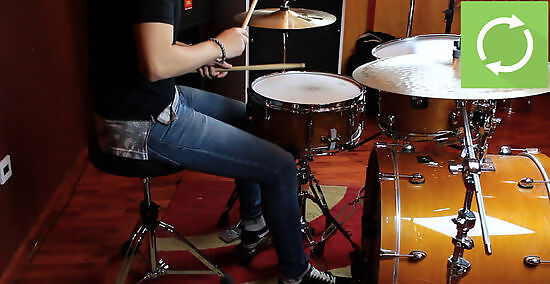
Practice rolling with one foot before adding in the other. Start slowly rolling both feet while playing and gradually increase your speed once you get the hang of it. You’ll be able to play faster and more complicated rhythms with this rolling method. Black Sabbath’s “Black Sabbath” and Metallica’s “Sad But True” are both easier songs to learn (slowly at first) while you practice this technique. Start slow and be patient with yourself! Practice rolling your feet on the ground while you’re sitting, going very slow and paying close attention to the parts of your foot that are making contact with the ground. Do calf raises and standing toe lifts to increase strength and flexibility in your foot and leg muscles. Use the video recorder on your phone to record your feet while you practice. You’ll be able to spot any technical errors and see if one foot needs more work than the other. If one foot is weaker, practice rolling that foot on the floor when you’re sitting or doing other activities to strengthen those muscles.













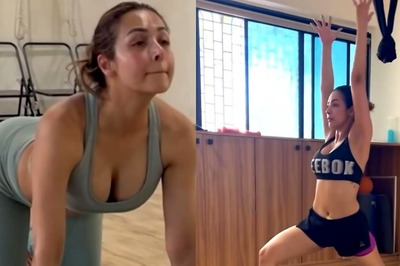
Comments
0 comment